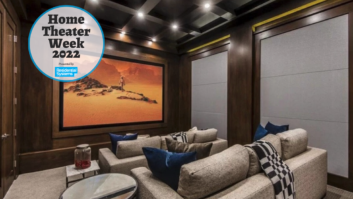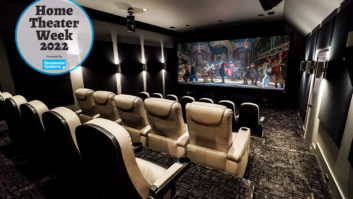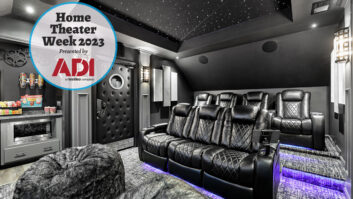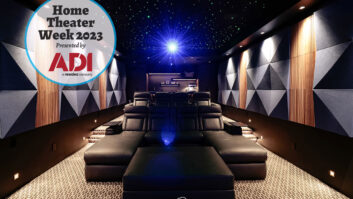Advances in technology have transformed just about every space of a home. Kitchens have become communication hubs, bathrooms have blossomed into spa-like retreats, outdoor areas have turned into popular entertainment destinations, and bedrooms have become private luxury refuges. Technology has influenced not only how these spaces function, but how they look. While kitchens, bathrooms, bedrooms, and even the outdoors have been impacted by progressively smarter technology, it’s the home theater that’s undergone the most monumental change. Brighter, bigger displays; smaller, sleeker speakers; and completely new ways to consume and enjoy entertainment content, as well as socioeconomic forces, have altered the home theater landscape.
Given the lightning pace by which technology advances, home theater is one of the most dynamic areas of a household to decorate. So, what’s influencing home theater design in 2020? Bold colors or neutrals? Huge video walls or smaller screens? Speakers that stand out or ones that hide in the walls? Which elements of design should be incorporated today to stay on trend? Here are ten of the biggest trends shaping home theater design today:
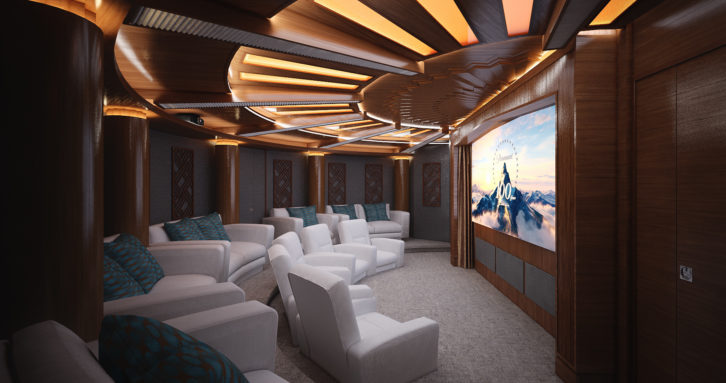
1. Multi-Use Entertainment
Historically, a home theater was designed as a room dedicated to one thing and one thing only: watching movies. While this particular approach is still practiced today, what’s become increasingly common are home theaters that facilitate other forms of recreation. For many families, a multipurpose entertainment area makes a lot of sense. They may not have the free space or the funds to allocate a large chunk of their homes to movie viewing, so designing the room to accommodate other activities — watching sporting events, playing video games, listening to music, practicing yoga, you name it — offers more bang for the buck. As home entertainment becomes increasingly multifaceted, so must the design of the room. Rather than outfit the space with stadium-style seating, for example, it’s become more important to provide a large, open floor space for exercising and interactive gaming. Lighting also needs to be more multifunctional — bright during sporting events, soft and serene for music listening, and completely dark for movie viewing, for example.
2. Large-Scale Lounge Seating
Coinciding with the multipurpose entertainment movement is the growing popularity of lounge-style seating. Families are spending more time at home than ever before, so comfort is crucial…right down where they rest their backsides in a home theater. Individual seats that flip down certainly evoke the look and feel of a commercial cinema, but today it’s more in vogue to complement these traditional home theater seats with large plush couches, ottomans, and sectionals similar to what you’d see in a lounge. Together, the traditional and modern seating styles provide the perfect marriage of form and function.
Also by Lisa Slayman: The Key to a Better Builder Relationship
3. Modern Design Elements
A home theater should reflect its owner’s taste and style. If that’s traditional, outfit the space with ornate, indulgent furnishings and architectural details. These days, however, a contemporary, modern design is resonating with more homeowners, and that’s carrying through to the home theater. Clean, subtle, and with softer lines, the contemporary design concept evokes a sense of comfort and peace — an environment that befits a mult-iuse entertainment space of which home theaters have become. Riding on a spin bike or hosting a Super Bowl party might feel awkward in an opulent, richly appointed home theater, but completely appropriate in a modern media space.
4. Light, Neutral Color Palettes
Complementing the contemporary home theater design trend is the application of lighter, more neutral color schemes. Paint, fabrics, and furnishings are following suit, creating a home theater that feels open and airy rather than dark and cavernous.
5. Family-Friendly Atmosphere
The contemporary influences, the neutral tones, the accommodation of comfortable seats and access to a wide variety of entertainment — it’s all led to the demise of the once-popular “man cave.” Home theaters of yesteryear used to be the domain of the man in the house — where he escaped to unwind from a hard day at the office. Those days are over, and today’s home theater designs reflect this evolution. Environments that cater to the interests of everyone in the household are now deemed most desirable.
6. Themes
Hobbies, past-times, and passions come to life in home theaters. Usually set apart from the rest of the home, the space offers an open canvas on which to paint the portrait of your life. It’s a chance to let your imagination and creativity run wild. Interested in Art Deco? Love the look of 1930s Hollywood glamour? These and other design elements can give a home theater a style all its own, and make each visit feel as if you’ve stepped into another space and time.
7. Bigger Screens, Brighter Images
As technology continues to evolve, so does the form and function of a home theater. Screens, for example, have grown increasingly larger and projectors increasingly brighter. It’s an ideal situation for home theaters, as the objective during movie viewing is to evoke a similar visual experience as that of a commercial cinema. Total immersion and engagement of the presentation are trending, and big screens are leading the charge. Concurrent with epic screen proportions is the application of screen materials to ensure the reproduction of bright, vivid images regardless of the room lighting. Ambient light rejection screens are a blessing for multipurpose home theaters, as the image retains its brightness in all viewing situations. You can keep the lights on while hosting a Super Bowl party or completely off during a movie and the image is always crisp, clear and bright.
8. Colorful Lighting
Now that screens and projectors can perform optimally under any lighting conditions, home theater designs are incorporating more light fixtures than ever before — and not just standard white light, but colorful LED lighting that evokes mood and ambiance. With the addition of these lights, and an easy way to control them, the atmosphere transitions from that of a relaxing getaway with blue lighting to an energetic disco with yellow and orange hues. When the Packers play, get the whole room into the spirit by washing the walls in a bright green hue; add splashes of red during the holidays.
9. LED Video Walls
LED video wall technology offers a new, exciting option to the traditional projector-screen setup. Video walls suit a more dynamic home theater environment, where one minute you’re using the screen to watch YouTube videos, the next to gaze at a stunning piece of artwork, and the next to take in the scenery along a hilly Tuscan bike trail as you jump onto your connected stationary bike. Or maybe you like to do two things at once — view the landscape while peeking in on the news. Images on video walls can be scaled to any size or shape so that multiple pieces of content can be displayed at the same time.
10. Decorative Acoustical Treatments
Lifelike, three-dimensional audio in home theater environments has taken off, thanks to technologies like Dolby Atmos. The processor and speakers do much of the work to create the effect, but the audio quality can be optimized through the application of acoustical paneling and other types of treatments by a professional acoustician. To raise no visual conflict with the room design, acoustical treatments can be concealed in specially constructed wall cavities and covered with acoustically transparent fabric or fashioned as decorative elements within the room.
With more than 20 years of experience designing luxury home theaters for high-end properties around the globe, plus an extensive understanding and appreciation for AV technology, Lisa Slayman of Slayman Cinema and Slayman Design Associates is a valuable resource for home systems integrators. Slayman Cinema has won several awards, including the International Best Overall Home Theater from CEDIA. Slayman is also a member of the American Society of Interior Designers and the International Interior Design Association.
Want more stories like this delivered to your inbox every day? Then sign up for the free Residential Systems eNewsletter here.
